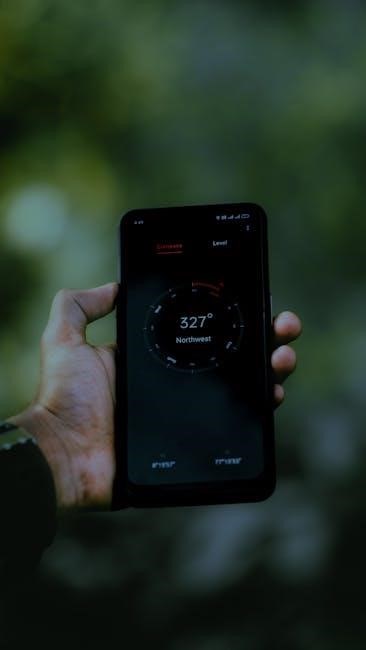Modern witchcraft is a vibrant, evolving spiritual practice․ It blends ancient traditions with contemporary insights․ This guide explores its history, practices, benefits, and how to begin your own journey․ It is a dynamic blend of tradition and innovation․
What is Modern Witchcraft?
Modern witchcraft is a spiritual path that draws upon ancient traditions, incorporating contemporary practices․ It’s not a singular, monolithic religion but a diverse range of beliefs and practices․ Many modern witches emphasize a connection with nature, often revering both a God and a Goddess․ It’s a practice centered on personal empowerment, seeking to harness cosmic or psychic forces for positive change․ Unlike some occult traditions, modern witchcraft typically focuses on enhancing life and promoting healing․ It is less about malevolent magic and more about creating a positive impact․ It’s an individualized journey, often blending traditional elements with modern sensibilities․ The incorporation of modern tools deepens the spiritual connection and allows for innovative magical practices․ This craft is a continuous evolution, adapting to the changing world while honoring its roots․ It’s about finding a personal path to magic and self-discovery․ It is a path for those seeking a connection with nature, magic, and themselves․
Historical Roots and Evolution
The historical roots of modern witchcraft trace back to ancient cultures, where magic and spirituality were intertwined․ Belief in witchcraft as malevolent magic is found in ancient Mesopotamia and Europe․ In medieval and early modern Europe, accused individuals faced trials for witchcraft․ Modern witchcraft, however, is not a direct continuation of these historical practices․ It is a reconstruction of older magical practices with later influences․ The term “Neo-Paganism” encompasses many groups trying to reconstruct ancient pre-Christian religious systems․ Wicca, a modern witchcraft tradition, emerged in the mid-20th century․ It drew inspiration from various sources, including older magical practices and folk beliefs․ Modern witchcraft continues to evolve, incorporating contemporary insights and tools․ This evolution involves a balance between honoring tradition and embracing innovation․ It’s a continuous process of rediscovering and reimagining the ancient ways in a contemporary context․ It is a tapestry woven from the threads of history and the threads of our modern understanding of the world․
Key Elements of Modern Witchcraft
Modern witchcraft has key elements forming its foundation․ These include rituals, practices, beliefs, connection with nature, empowerment, and ethics․ These elements are integral to the practice and understanding of the craft․
Rituals and Practices
Rituals form a significant part of modern witchcraft, often involving spells and ceremonies․ These practices are designed to harness and focus energies for various purposes, such as healing, personal growth, or manifestation․ Many modern witches incorporate elements from diverse traditions, creating unique and personalized rituals․ These might include setting up an altar, using specific tools like wands or crystals, and invoking deities or energies relevant to their intentions․ The use of herbs, oils, and candles are also common in ritualistic practices․ The emphasis is on intention and the connection to the natural world․ They also include practices like tarot reading, using essential oils, or celebrating the Wheel of the Year․ Rituals can be performed alone or in a group, depending on the witch’s preference and the nature of the practice․
Beliefs and Philosophy
Modern witchcraft encompasses a wide range of beliefs and philosophies, often centered around the interconnectedness of all things․ Many witches revere both the God and the Goddess, seeking a friendly relationship with their natural environment and recognizing the sacredness of nature․ Unlike some other occult religions, modern witchcraft aims to use cosmic or psychic forces to enhance life and promote healing․ It emphasizes personal empowerment, intuitive wisdom, and the exploration of one’s inner self․ There is often a focus on ethics, promoting positive actions and avoiding harm․ A core belief is that individuals have the power to shape their own reality through intention and will․ This belief system is inclusive, allowing for diverse paths and perspectives within the practice․
Connection with Nature
A profound connection with nature is a cornerstone of modern witchcraft, with practitioners recognizing the sacredness of the natural world․ This connection goes beyond mere appreciation, involving active engagement and reverence for the Earth’s cycles and rhythms․ Witches often celebrate the turning of the seasons, honoring the Wheel of the Year, which marks the solstices, equinoxes, and other significant times․ They may work with herbs, stones, and other natural elements, understanding their inherent energies and properties․ This relationship with nature is not just symbolic but deeply experiential, influencing rituals, spells, and daily practices․ It’s a reciprocal relationship where witches strive to live in harmony with the environment, understanding that their well-being is interconnected with the health of the planet․ Many witches see nature as a manifestation of the divine․
Empowerment and Ethics
Modern witchcraft emphasizes personal empowerment, encouraging individuals to take control of their lives and embrace their inner potential․ It’s a path of self-discovery and growth, where practitioners are encouraged to trust their intuition and develop their unique abilities․ This empowerment is coupled with a strong ethical framework, often guided by the principle of “harm none․” Witches recognize that their actions have consequences and strive to use their powers responsibly․ Ethics in witchcraft also involve respecting the free will of others and avoiding manipulation․ Practitioners focus on positive intentions and use their magic for healing, growth, and overall well-being․ The concept of personal responsibility is central, understanding that with power comes the need for careful consideration and ethical decision-making․ This combination of empowerment and ethics creates a path of self-mastery and balanced spiritual practice․
Modern Witchcraft in Practice
Modern witchcraft manifests in diverse ways․ Wicca is a structured tradition, while eclectic witchcraft embraces varied paths․ Modern tools and technology are integrated into magical practices, reflecting a contemporary approach to the craft․
Wicca as a Modern Tradition
Wicca stands as a significant modern witchcraft tradition․ It’s a religious movement that incorporates witchcraft practices, emphasizing the cycles of nature․ Wicca often involves the worship of both a God and a Goddess․ This duality reflects the balance and interconnectedness within the natural world․ It is a structured path with specific rituals, beliefs, and a focus on ethical conduct․ The Wheel of the Year, with its eight seasonal festivals, is central to Wiccan practice․ It celebrates the changing seasons and their significance․ Wicca seeks to create a harmonious relationship with the natural environment and utilize cosmic forces for positive purposes․ It contrasts with other occult religions like Satanism, emphasizing life enhancement, healing, and community building․ It is a path that seeks to revere the divine in all aspects of the world․
Eclectic Witchcraft and Diverse Practices
Eclectic witchcraft offers a vast landscape of diverse practices, drawing from varied traditions and beliefs․ It’s a path that celebrates individual freedom and exploration, not bound by rigid rules․ Eclectic witches often incorporate elements from different spiritual and magical systems․ This can include practices from ancient pagan religions, herbalism, folk magic, and even modern psychological principles․ The emphasis is on personal experience and what resonates with the individual’s unique needs and values․ This approach encourages creativity, allowing practitioners to develop a personalized path․ It often includes practices like tarot reading, using essential oils, and celebrating the Wheel of the Year․ This blend of traditional and modern elements reflects a dynamic and ever-evolving approach to witchcraft; Ultimately, eclectic witchcraft is about finding your own unique way within the craft․
Incorporating Modern Tools and Technology
Modern witchcraft uniquely integrates contemporary tools and technology to deepen spiritual connection․ This includes using online platforms for community building and accessing information․ Virtual altars allow practitioners to engage in rituals from anywhere․ Technology enables magical practices in ways not previously possible․ It connects individuals across geographical boundaries, fostering a sense of shared experience and knowledge․ Social media facilitates the sharing of spells, rituals, and personal journeys, creating a supportive and accessible learning environment․ Modern witches also utilize apps for tracking lunar cycles, managing herbal remedies, and practicing mindfulness․ These digital tools enhance, rather than replace, traditional methods․ The use of technology reflects a forward-thinking approach, empowering practitioners to explore their craft in innovative and meaningful ways, blending the old with the new․
Contemporary Relevance
Modern witchcraft addresses mental health through empowerment and healing․ It balances tradition with innovation, fostering a revival․ This revival reflects a desire for spiritual connection in the modern world․ Its practices are evolving and intricate․
Witchcraft and Mental Health
The connection between witchcraft and mental well-being is increasingly recognized within the modern practice․ Many individuals find empowerment and healing through engaging with witchcraft․ The practice offers a unique avenue for self-discovery and personal growth․ It provides a sense of agency, allowing practitioners to actively shape their lives․ This feeling of control can be particularly beneficial for those struggling with feelings of helplessness or anxiety․ Furthermore, the rituals and practices within witchcraft can be very therapeutic․ They offer structured ways to process emotions and develop coping mechanisms․ The focus on nature and the cyclical rhythms of the earth can bring a sense of grounding and stability․ Personal stories of individuals who have found solace and healing through witchcraft are becoming more common, highlighting the potential of this spiritual path as a tool for improving mental wellness․ This aspect of witchcraft is a powerful act of rebellion․
Balancing Tradition and Innovation
One of the defining characteristics of modern witchcraft is its ability to harmonize respect for tradition with the embrace of innovation․ Practitioners often draw from ancient practices and beliefs, integrating them with contemporary sensibilities․ There’s a conscious effort to honor the historical roots of witchcraft while acknowledging that it is a living, evolving tradition․ This means that while traditional rituals and ceremonies hold significance, modern witches also feel empowered to adapt and modify them to better suit their individual needs and modern lifestyles․ The use of modern tools and technology is a prime example of this balance․ Virtual altars, online communities, and digital spellbooks are increasingly integrated into practice, enhancing accessibility and connectivity for modern witches․ This dynamic approach ensures that witchcraft remains relevant and meaningful in the 21st century․ It allows for a diverse range of expressions and practices, reflecting the unique paths of individual practitioners․ This balance is key to the revival of modern witchcraft․
The Modern Witchcraft Revival
The resurgence of witchcraft in recent times marks a significant cultural shift, with growing numbers embracing its practices and philosophy․ This revival is fueled by a variety of factors, including a desire for spiritual connection outside of traditional religious frameworks, a growing interest in nature-based spirituality, and an increasing awareness of the power of personal empowerment․ The rise of social media has also played a crucial role, creating online communities that allow modern witches to connect, share their experiences, and access resources․ This increased visibility has helped to dismantle negative stereotypes associated with witchcraft and has fostered a more inclusive and accepting environment․ The modern witchcraft revival is not just about adopting ancient practices; it’s also about reclaiming agency, challenging societal norms, and finding meaningful pathways for spiritual growth and self-discovery․ It represents a powerful act of rebellion and a quest for personal and collective empowerment․ This resurgence demonstrates that witchcraft is a living, evolving tradition with continuing relevance․



About the author